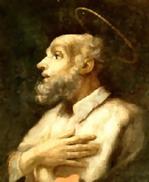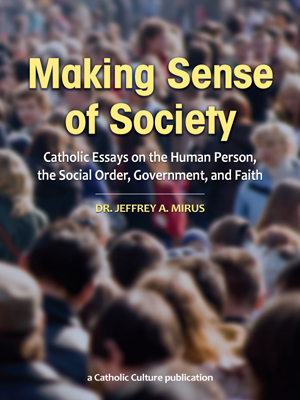Make your gift today!
Help keep Catholics around the world educated and informed.
Already donated? Log in to stop seeing these donation pop-ups.
What Would the World be, Ancient and Modern, without Consecrated Life?
1. Quia fecit mihi magna. "For he who is mighty has done great things for me" (Lk. 1:49).
We conclude the work of the ninth ordinary general assembly of the Synod of Bishops, dedicated to consecrated life and its mission in the church and in the world, with this celebration. We close them on a Saturday - a day traditionally dedicated to the mother of God. Therefore, we address ourselves to Mary in a particular way in today's eucharistic sacrifice, borrowing the words of thanks from the Magnificat, which the church repeats every day in the Liturgy of the Hours: "He has done great things for me." Fecit mihi magna.
Vatican Council II was a "great thing" for the church, which could correctly be defined as the most significant ecclesial event of our century. On the background of this first and fundamental "great thing," given to us by the Lord, other "great things" can be recognized, achieved by him during the recent past. The institution of the Synod of Bishops may surely be placed among these, which by now has its own history, developed during the postconciliar period. This last synodal assembly can now be recorded in its history, which was greatly expected and - we all hope - not less fruitful than the preceding ones.
To the apostolic exhortations Familiaris Consortio, Christifideles Laici, Pastores Dabo Vobis thus now we will have the joy of following with a new postsynodal document, of which we still do not know the incipit but which certainly will reflect what has emerged during the course of the assembly, which ends today. There have been weeks of intense work during which consecrated life and its mission have been at the center of reflection and prayer by the church.
2. My soul thirsts for God, for the living God" (Ps. 42:3). The readings proclaimed now contain many lights able to make clear the singular state of ecclesial life which is consecrated life. The responsorial psalm remembers the liturgy of baptism with the blessing of the holy water during the great paschal vigil of Holy Saturday.
Baptism is the first and fundamental consecration of the human person. Beginning new existence in Christ, the baptized-man or woman -participates in this consecration, in this total donation to the Father which is proper to his eternal Son. It is he himself-the Son-who incites in man's soul the desire to give oneself without reservation to God: My soul thirsts for God, for the living God. When shall I come and behold the face of God?" (Ps. 42:3).
Religious consecration, with its distinct eschatological dimension, is inserted on baptismal consecration. No one has ever seen God (cf. Jn. 1:18) during this life. This is however the beatific vision, that is, the seeing of the visage of God "face to face" (1 Cor. 13:12), the definite vocation beyond time of each man. Consecrated persons have the duty of reminding everyone of this. Faith prepares us for this beatific vision, in which God gives himself to man with the measure of love with which this last one answered to the eternal love, revealed in the incarnation and in the cross of Christ.
3. "For to me, to live is Christ" (Phil. 1:21), writes Paul the apostle. Amori Christi nihil praeponatur, St. Benedict proclaims in his rules. Amori Christi in pauperibus nihil praeponatur, St. Vincent de Paul will say 1,000 years later.
What marvelous strength these words contain! Could one think about culture and European civilization without them? And the great missionary epics of the first and the second millennium, could they be imagined without them? And what to say about monasticism of the Eastern Christian, whose beginnings go back to the first centuries of Christianity? Thus, those who in following the poor, chaste and obedient Christ had abandoned the world, at the same time transformed it. In them was achieved the invocation: "Send forth thy Spirit and renew the face of the earth" (cf. Ps. 103:30). The Holy Spirit knows the "times and the moments" in which one must call upon persons suited for the duties required by the historical circumstances.
At that time, he called upon Benedict and his sister Scholastica. He called Bernard, Francis and Clare of Assisi, Bonaventure, Dominic, Thomas Aquinas and St. Catherine of Siena. From the public squares the Gospel reached the university chairs. At the time of the Eastern schism and the Reformation he called upon Ignatius Loyola, Teresa of Avila, John of the Cross and then Francis Xavier and Peter Claver. With them, a deep spiritual reform was achieved, and the missionary epic in the East and in the West began.
During the centuries closest to us the Spirit, which renews the face of the earth, called upon others such as John Baptist de La Salle, Paul of the Cross, Alphonse Maria Liguori and John Bosco, to only mention but a few of the most noteworthy ones. At the end of the last century and during the present, the same Spirit of the Father and of the Son spoke through Teresa of the Infant Jesus, through Maximilian Kolbe and through Sister Faustina.
What would the world be, ancient and modern, without these figures-and those of many others? They learned from Christ that "his yoke is easy and his burden is light" (cf. Mt. 11:30), and they taught this to others.
4. We conclude this synodal assembly almost on the eve of the solemnity of All Saints. The Book of the Apocalypse mentions this immense multitude, coming from every nation, people and tongue, standing before the heavenly throne and before the Lamb of God (cf. Rv. 7:9). The significant question follows: "Who are these clothed in white robes, and whence have they come?"
From where do they come? we also ask ourselves. Do they not come from the innumerable institutes of consecrated life, male and female, present in the church? The canonizations and the beatifications proclaimed through the centuries give witness of this. The beatifications, which during this month have almost accompanied the synodal way, give particular witness of this.
5. Today, the last Saturday of October, we offer up to you, Mary, mother and virgin, humble handmaiden of the Lord and queen of all the saints, the fruits of the work of the synod. We entrust them to you, queen of the holy rosary, queen of this beautiful prayer which has sustained us day by day during the entire month.
Make it possible that these fruits, through a singular exchange of gifts, may be useful also to the cause of the family, complying with the design of divine providence, which desired the celebration of this symbol on consecrated life during the Year of the Family.
They praise you, Lord, the consecrated persons. They praise you, the Christian families of the entire world. She praises you, the church, for the gift of the synod.
This item 5454 digitally provided courtesy of CatholicCulture.org






